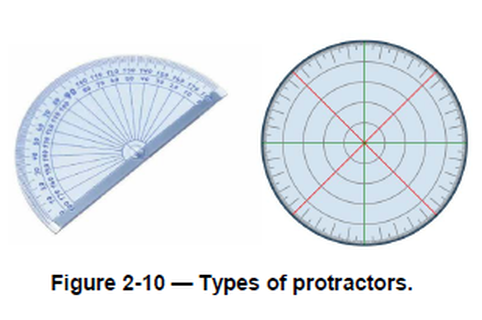
Protractors
(Figure 2-) are used for measuring and laying out angles other than those drawn with the triangle or a combination of triangles. Most of the work you will do with a protractor will involve plotting information received/got from field surveys. Like the triangle, most protractors are made of clear plastic. They are available in 6-, 8-, and 10-inch sizes and are either circular or half-circle in shape.
Protractors are usually graduated in small steps toward/upward of half of a degree. By careful guess, you may get angles of 1/4 degree. Protractor numbering arrangement differs/changes. Half-circle protractors are usually labeled from 0 to 180 degrees in both directions. Circular protractors may be labeled from 0 to 360 degrees (both (when a wheel turns so the top moves to the right) and (when a wheel turns so the top moves to the left)), or they may be labeled from 0 to 90 degrees in four (one-fourth of areas). Stow and care for protractors in the same manner as triangles.
(Figure 2-) are used for measuring and laying out angles other than those drawn with the triangle or a combination of triangles. Most of the work you will do with a protractor will involve plotting information received/got from field surveys. Like the triangle, most protractors are made of clear plastic. They are available in 6-, 8-, and 10-inch sizes and are either circular or half-circle in shape.
Protractors are usually graduated in small steps toward/upward of half of a degree. By careful guess, you may get angles of 1/4 degree. Protractor numbering arrangement differs/changes. Half-circle protractors are usually labeled from 0 to 180 degrees in both directions. Circular protractors may be labeled from 0 to 360 degrees (both (when a wheel turns so the top moves to the right) and (when a wheel turns so the top moves to the left)), or they may be labeled from 0 to 90 degrees in four (one-fourth of areas). Stow and care for protractors in the same manner as triangles.